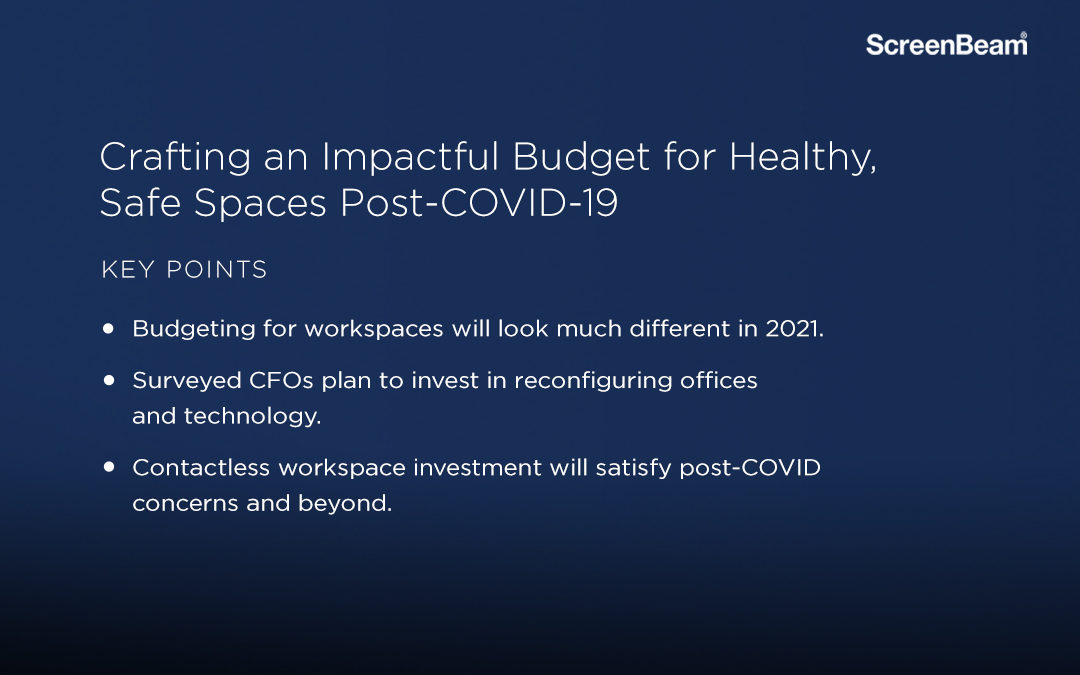Work environments endured a cataclysmic shift in 2020 due to the pandemic. In many cases, almost all workers went home to work. That model works for some businesses, but clearly there have been significant challenges and costs.
Additionally, more companies are starting to plan on how they want to welcome back workers to the office in the new year. The focus on workspaces has changed as well, but the need for collaboration has not.
As employers look to reimagine their offices, they’ll need to adjust and reallocate budgets. To ensure your spaces are healthy, safe and support collaboration, you don’t need to spend a lot for a major impact.
Spending Looks Different in 2021
Developing a 2021 budget can be a complicated exercise. You can’t necessarily look at last year’s history to budget because everything’s changed dramatically. There have already been significant changes in spending. Consider the investments that companies typically make in trade shows, in-person events and business travel. Those went to zero in Q2 2020, and likely won’t pick back up until the pandemic end.
So, what are CFOs (chief financial officers) saying about budgeting? A PwC survey of 330 U.S. CFOs revealed the following:
- 71% of CFOs are confident in their company’s ability to provide a safe working environment, while 59% have concerns about rising infections affecting return to work.
- 70% of CFOs said better hardware and equipment are necessary for return to work, and 56% said technology investments would help their company in the long run.
- When asked about return-to-work transitions, CFOs said these were the top things to implement: changing workplace safety measures and requirements (81%) and reconfiguration of worksites to promote physical distancing (78%).
Takeaways from the Survey
Based on the data point above, CFOs have clear concerns about return to work. They are also thinking about the budgetary changes they need to make. Most businesses will allocate significant budget dollars in 2021 to COVID-related adjustments.
The spend for that is likely on reconfiguring office space, technology to assist employees allowing them to work together safely, and enhanced cleaning/disinfecting procedures.
Ensuring Your Post-COVID Budget Has the Right Impact on Workspaces
Budgeting is rarely a linear process, and most companies opt to adjust top-line budget amounts by a flat percentage based on what’s expected in the coming year, but COVID-19 has forced companies to be more hands on.
Zero-based budgeting refers to a traditionally unpopular method in which executives are asked to justify and approve each expense. This is challenging in terms of additional work and complexity. However, in the wake of the COVID-19 pandemic, zero-based budgeting is gaining popularity for its ability to help companies more surgically remove certain line items while at the same time introducing key items for successfully navigating the pandemic.
Instead of cutting based on a percentage, executives can go over expenses with a fine-tooth comb, likely resulting in greater savings – sometimes to the tune of millions – and a refocusing on positive spending, such as that geared toward new normal-ready spaces for collaboration.
Zero-based budgeting can also aid your organization in planning for long-term shifts like the kind COVID engineered in industries around the globe, meaning you can craft a budget more applicable to the workplace you envision for 2021 and beyond.
What Areas Should Businesses Invest in 2021?
When it comes to office design, configuration, and technology of workspaces, conventional and traditional budgeting is out the window. Instead, you’ll need to focus on these things:
- New layouts: Open office spaces were a trend for many years to boost interaction. Now interaction needs to be at a distance. Workstations likely need to be spaced out. Workers will still need to talk and plan together, bringing about more collaboration hubs that enable distancing.
- Limiting surface touches: In a building, there are so many touchpoints—door handles, light switches, etc. There are innovative ways to limit these with motion lights and doors that swing both ways that only need a push from your foot.
- Cleaning and disinfecting services: Another line on your budget will need to go to cleaning and disinfecting services. You may contract for these with a third-party for weekly cleans, but it’s also a good idea to designate an employee to do regular wipe downs, so you’ll need dollars for products as well as hand sanitizer kiosks.
- Contactless workspaces: You can virtually eliminate contact points in meeting spaces with contactless wireless display technology. Be sure to choose a solution where there are no apps, dongles, or switches to make it safe and for your employees, while minimizing complexity for your IT department. With such a setup, your team can connect to meeting room displays, share files and collaborate wirelessly in real-time. It’s a turnkey platform, not something your IT team has to integrate or hobble together.
Wireless Display and Conferencing Tech Is a Long-Term Investment
Of these investments, the first three may be short-term or one-time investments. Technology spend is long-term and incremental. The shift to contactless wireless display and conferencing was already happening before COVID. COVID accelerated it to the point where it’s now a must-have, not a nice to have.
Beyond the ease of use and ability to bring workers together, it also integrates with unified communications (UC) platforms enabling hybrid meetings. Thus, your budget should reflect that purchasing a system isn’t only applicable to the post-COVID work environment but actually future-proofs your technology stack for communication, collaboration, and productivity.
Learn more about how ScreenBeam enables safe workplace collaboration for business with the ScreenBeam 1100 Plus.
